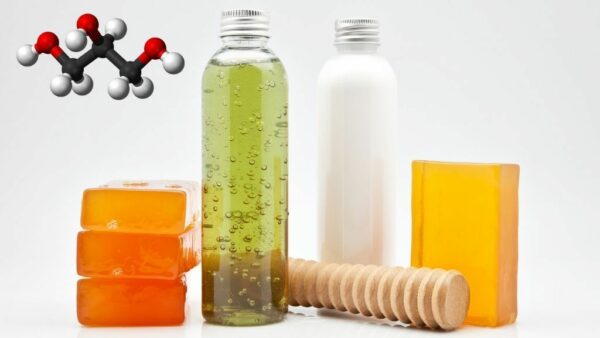Glycerin is a type of sugar alcohol derived from oils, petroleum, or animal products. It is a clear, colourless, odourless liquid with a syrupy texture and a sweet taste that functions as a humectant and moisturizing agent. Its main function is to pull water from the deeper, inner levels of the skin into the more vulnerable outer layer. It is a common ingredient in various skincare products that contain it primarily because of the effectiveness of the combination of Glycerin and occlusive, i.e. barrier, agents. Occlusive agents reduce the loss of water through the skin by forming a hydrophobic layer on the surface of the stratum corneum. They are beneficial as a moisturizing agent for the skin.
This article gives you a review of the following topics:
- The uses and benefits of Glycerin
- About vegetable Glycerin
- Health benefits of vegetable Glycerin
- Uses of Glycerin liquid
- Possible side effects of Glycerin
The uses and benefits of Glycerin
A 2016 study by Trusted Source examined a number of humectants, including alpha-hydroxy acids, hyaluronic acid, sorbitol and Glycerin. The latter was rated the most effective. Thanks to its hydrating properties, Glycerin can be used as a treatment to prevent dry, flaky skin and other skin irritations. The background for this is that Glycerin is able to soften and hydrate the skin, reducing unpleasant symptoms.
The primary cause of dry skin is water loss in the upper layer of the skin. To prevent this, the moisturizing products form an oil-rich layer on the surface of the skin that traps water and then the Glycerin transports it to the outer layer of the skin. Many products containing Glycerin also contain beneficial ingredients that break up a compound called keratin, which binds cells on the surface of the skin. This process helps remove dead skin cells, maintains the balance of the skin’s water levels, and the end result is smoother softer healthier skin.
Since Food and Drug Administration classifies Glycerine as safe, it can be used both as a sweetener and a preservative in certain foods. Those struggling with constipation may also benefit from Glycerin because it has the ability to transport fluids into the gastrointestinal tract. This so-called hyperosmotic laxative effect is attributed to vegetable Glycerin, which helps the already digested food to move more easily through the intestinal tract. Glycerin can also be used in the form of a suppository. An earlier study showed that this form of rectal suppository proved significantly effective in combating constipation caused by analgesic drugs compared to other laxatives.
About vegetable Glycerin
Vegetable Glycerin is a type that is made from vegetable oils. It was discovered by chance more than two centuries ago when a mixture of olive oil and lead oxide was heated. Its industrial importance increased in the late 1800s when it was first used to make dynamite. Nowadays, vegetable Glycerin is produced by heating triglyceride-rich vegetable fats – such as palm, soybean or coconut oils – under pressure or with a strong alkali compound. During this process, the Glycerin separates from the fatty acids and then mixes together with water to form an odourless, sweet-tasting, syrupy liquid. This type of Glycerin is widely used in the food, cosmetics, and pharmaceutical industries.
It is common to use it in foods as it helps to mix the oil and water-based ingredients, sweetening or raising the moisture levels in the final product. It can also prevent the formation of ice crystals in frozen foods. Glycerin is a commonly used ingredient in pharmaceutical drugs – such as heart medications, suppositories, cough remedies and anaesthetics –, and also in soaps, lotions, deodorants, makeup products and toothpaste. In toothpaste, Glycerin helps prevent it from drying out or hardening in the tube.
Health benefits of vegetable Glycerin
Vegetable Glycerin has numerous health benefits, however, only a few of them are supported by science, and more studies are needed. The following have the most research behind them.No wonder Glycerin is such a popular skin care treatment. Research shows that applying Glycerin improves the skin’s softness, using creams that contain Glycerin can increase hydration in only 10 days. Two studies have proven this. In the first study, they compared the Glycerin-based cream and creams made from silicone oil or hyaluronic acid. It was proven that the Glycerin-based cream was more effective at hydrating the skin and preventing loss of moisture. In the next study, they found that if they add Glycerin to a warm water bath, it was more effective at improving moisture levels and protecting against skin irritation than a warm water bath alone.
Thus, these studies showed that vegetable Glycerin may lead to better skin health, protects against infections, and is also effective in wound healing. Given the increased hydrating capabilities of vegetable Glycerin, it can also improve your athletic performance. Frequent sweating can cause chronic dehydration when exercising. We would think that drinking enough liquids may help avoid this. It can be impractical to drink during certain types of physical activity. If an athlete drinks large amounts in a short time span, the fluid is generally lost through urine or sweating in the next hour. Studies have shown that drinks containing Glycerin increase water retention, which lead to improvements in athletic performance.
Uses of Glycerin liquid
When using liquid Glycerin, it is advisable to follow the instructions on the product packaging and to consult a physician or a pharmacist if you have any questions. Shake all products before use. It is recommended to apply Glycerin to the problem skin area as needed or as advised by your doctor. The frequency of use depends on the product or the specific skin condition. For dry hands, for example, it is recommended to apply liquid Glycerin to the hands after washing them.
However, if we want to treat diaper rashes, we should clean the skin surface first and allow it to dry before using Glycerine. In the event of a burn caused by radiation, it is advisable to consult a specialist before using a Glycerin product.
It is also important to avoid sensitive areas such as your eyes, inside your mouth, nose and genitals, unless advised otherwise by the packaging or your doctor. For more serious skin problems, fractures, cuts or freshly shaved skin, it is also advisable to consult a doctor or a pharmacist for details.
Once you know how to use the product safely, regular use and the presence of water can greatly increase its effectiveness. That is why you should apply Glycerin after taking a bath or a shower, while your skin is still wet. If your skin is particularly dry, your doctor may advise you to soak the problematic skin surface before use and avoid taking long, hot baths, as they may worsen the condition.
Possible side effects of Glycerin
As a humectant, Glycerin can extract water from the nearest sources, which are the lower layers of the skin, especially in conditions of low humidity. This can result in dehydration and blistering, but this can easily be avoided by diluting 100% Glycerin before use. Natural skin-care product proponents recommend mixing it with rose water. Rosewater hydrates the skin and refines pores in addition to its positive antioxidant effect. Glycerin is generally considered safe, unpleasant side effects or allergic reactions are rare. If you experience a burning sensation, itching, other irritations, skin lesion or allergy symptoms (rashes, severe dizziness, difficulty breathing), seek medical attention immediately.


